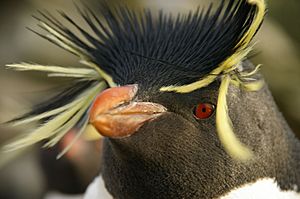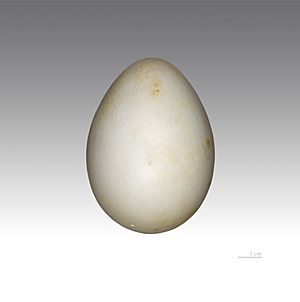Southern rockhopper penguin facts for kids
Quick facts for kids Southern rockhopper penguin |
|
|---|---|
 |
|
| An adult Southern rockhopper penguin in its home | |
| Conservation status | |
| Scientific classification | |
| Genus: |
Eudyptes
|
| Species: |
chrysocome
|
| Subspecies | |
|
See text:
|
|
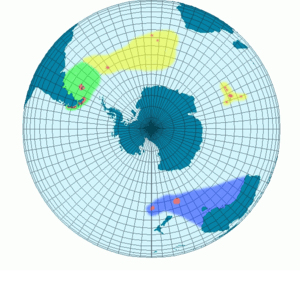 |
|
| Where rockhopper penguins live Green: western type, blue: eastern type |
|
| Synonyms | |
|
|
The Southern rockhopper penguin (Eudyptes chrysocome) is a type of rockhopper penguin. There are two main kinds, or subspecies, of Southern rockhopper penguins. They live in the cool waters of the Pacific Ocean and Indian Ocean near the South Pole. You can also find them along the southern coasts of South America.
Contents
What Does a Southern Rockhopper Penguin Look Like?
This penguin is the smallest of the "crested" penguins. These penguins have special yellow feathers on their heads. Southern rockhoppers are black and white. They grow to be about 45 to 58 centimeters (18 to 23 inches) tall. They usually weigh between 2 and 3.4 kilograms (4.4 to 7.5 pounds). Some very large ones have weighed up to 4.5 kilograms (9.9 pounds).
Their top parts are a dark grey color. They have bright yellow eyebrows that stick out. These eyebrows end in long, yellowish feathers that go sideways behind their red eyes.
Types of Southern Rockhopper Penguins
Scientists have different ideas about how to group rockhopper penguins. Some think all rockhopper penguins are just different types of the same species. Others believe there are three distinct types. For the Southern rockhopper penguin, there are two main types:
- Eudyptes chrysocome chrysocome: This is the Western rockhopper penguin. It lives and has its babies around the southern tip of South America.
- Eudyptes chrysocome filholi: This is the Eastern rockhopper penguin. It lives and has its babies on islands in the Indian Ocean and western Pacific Ocean.
The Northern rockhopper penguin lives in different ocean areas. It is also genetically different from the Southern rockhopper penguins. Rockhopper penguins are related to the macaroni penguin and the royal penguin.
Where Southern Rockhopper Penguins Live and What They Eat
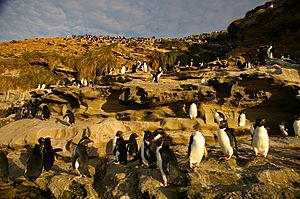
There are about 1 million pairs of Southern rockhopper penguins in the world. About two-thirds of them are the Western type. They live on the Falkland Islands and islands near Patagonia in South America. Important places include Isla de los Estados and the Diego Ramírez Islands.
The Eastern type lives on islands like the Prince Edward Islands, Crozet Islands, and Macquarie Island. When it's not breeding season, these penguins swim in the waters near their homes.
These penguins eat many different things from the ocean. Their diet includes:
- Krill (tiny shrimp-like creatures)
- Squid and octopus
- Lanternfish
- Other small crustaceans
A rockhopper penguin named Rocky lived for 29 years and 4 months. He lived at the Bergen Aquarium in Norway. Rocky passed away in 2003. This is the longest known life for a rockhopper penguin.
How Southern Rockhopper Penguins Behave
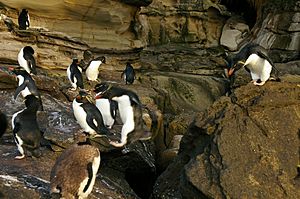
Their name "rockhopper" comes from how they move. Unlike many other penguins that slide on their bellies, rockhoppers jump over rocks and cracks. They use their strong legs to hop around.
Other "crested" penguins also hop, but rockhoppers were the first ones explorers saw doing this. This is because rockhoppers live in places that people visited a long time ago.
Reproduction and Life Cycle

Southern rockhopper penguins build their nests from the sea level up to cliff-tops. Some even nest further inland. Their breeding season starts in September and ends in November.
Female penguins usually lay two eggs. However, they typically only take care of one egg until it hatches. The egg hatches after about 35 days. The parents then keep the chicks warm for about 26 days.
How They Find Food
Rockhopper penguins are very good at finding food. They change how they look for food based on things like ice, how much food is available, and the time of year. They often leave and return to their colonies in groups when they go hunting.
They can travel far, sometimes up to 157 kilometers (97 miles) from their homes. Females usually hunt during the day. Their trips last about 11 to 12 hours and involve many dives. Sometimes, they will hunt at night, but these dives are much shallower.
Different Ways of Diving
Rockhopper penguins use two main types of dives to find food:
- Pelagic dives: These dives are usually short and not very deep. Penguins do these dives often.
- Benthic dives: These dives are much deeper, going close to the seafloor (up to 100 meters or 330 feet deep). They last longer. Penguins move quickly during these dives, around 6.9 to 8.1 kilometers per hour (4.3 to 5 miles per hour). These deeper dives often mean the penguins find more food. Other penguins like Emperor penguins and king penguins also use deep dives.
The amount of food available changes. Females bring back mostly small crustaceans and sometimes fish for their chicks. If there isn't much food, females can go without eating for a long time. They might only hunt for their chick's food.
Challenges When Hunting
Many things can make it hard for penguins to hunt. When they are breeding, laying eggs, or taking care of chicks, females cannot leave their nests for long. During these times, they follow a very strict hunting schedule. When it's not breeding season, they can go on longer trips. If a female penguin is tired from feeding chicks, she might make several short trips instead of one long one.
Deep dives are good for finding food, but they are hard on the penguins' bodies. Their lungs have limits on how long they can hold their breath. Rockhoppers can hold their breath for about 110 seconds for an aerobic dive. Some dives can even last up to 180-190 seconds.
Protecting Southern Rockhopper Penguins
The Southern rockhopper penguin group is considered a vulnerable species by the IUCN. This means their numbers have dropped a lot. Their population has gone down by about one-third in the last 30 years.
Things that threaten them include:
- Large-scale commercial fishing, which takes away their food.
- Oil spills, which can harm their feathers and make them sick.
Zoos in Europe work together to help these penguins. Drusillas Park in England helps manage the breeding programs for rockhopper penguins in European zoos. They share their knowledge to make sure these penguins can have healthy babies.
Penguins and People
Rockhopper penguins are very well-known among the "crested" penguins. Many tourists visit their breeding colonies, especially around South America. People enjoy watching these birds and their funny ways.
Long ago, these islands were popular stops for sailors and whalers. Almost all crested penguins you see in movies or books are based on the Southern rockhopper penguin.
Images for kids
See also
 In Spanish: Pingüino de penacho amarillo austral para niños
In Spanish: Pingüino de penacho amarillo austral para niños



